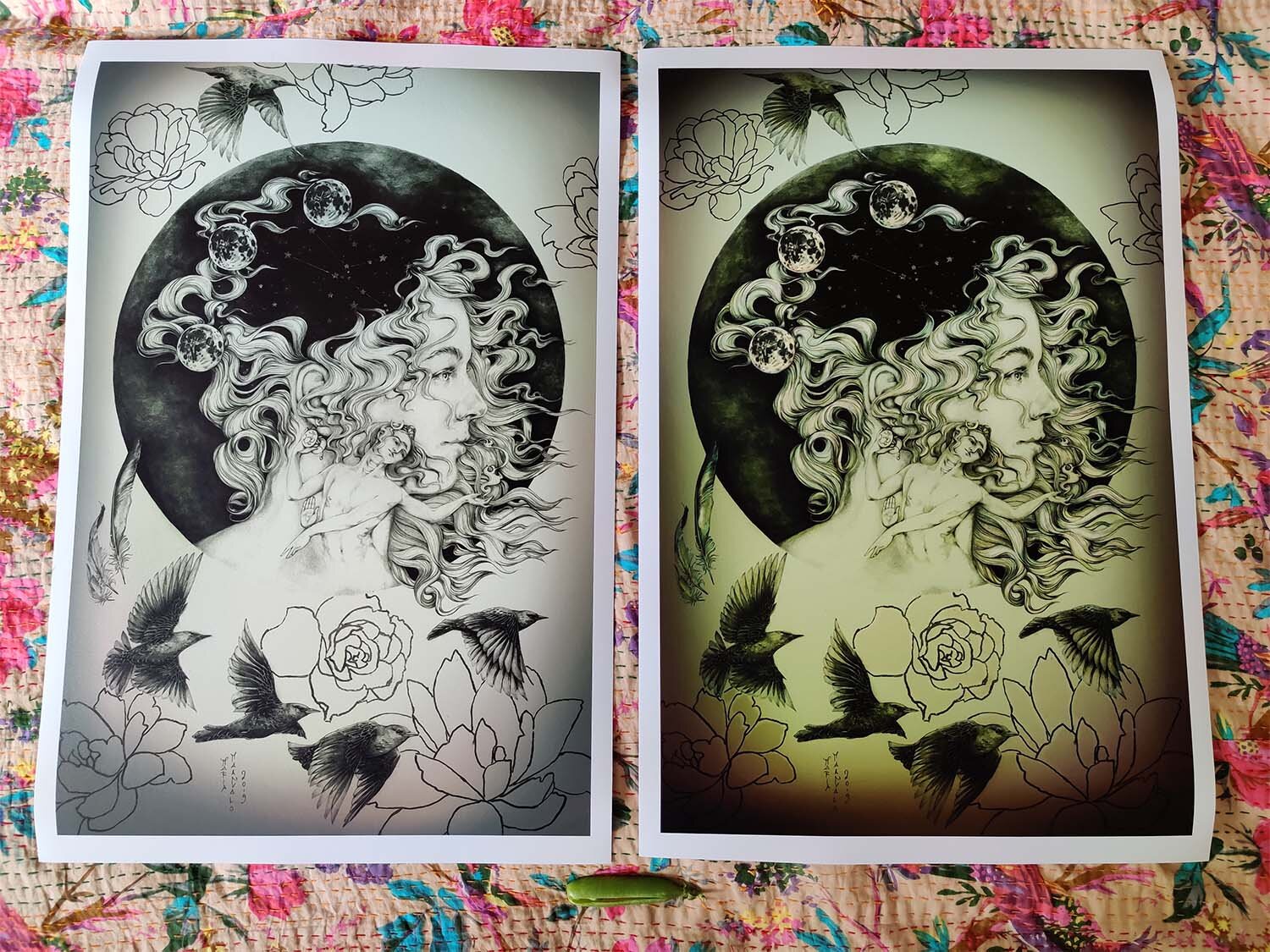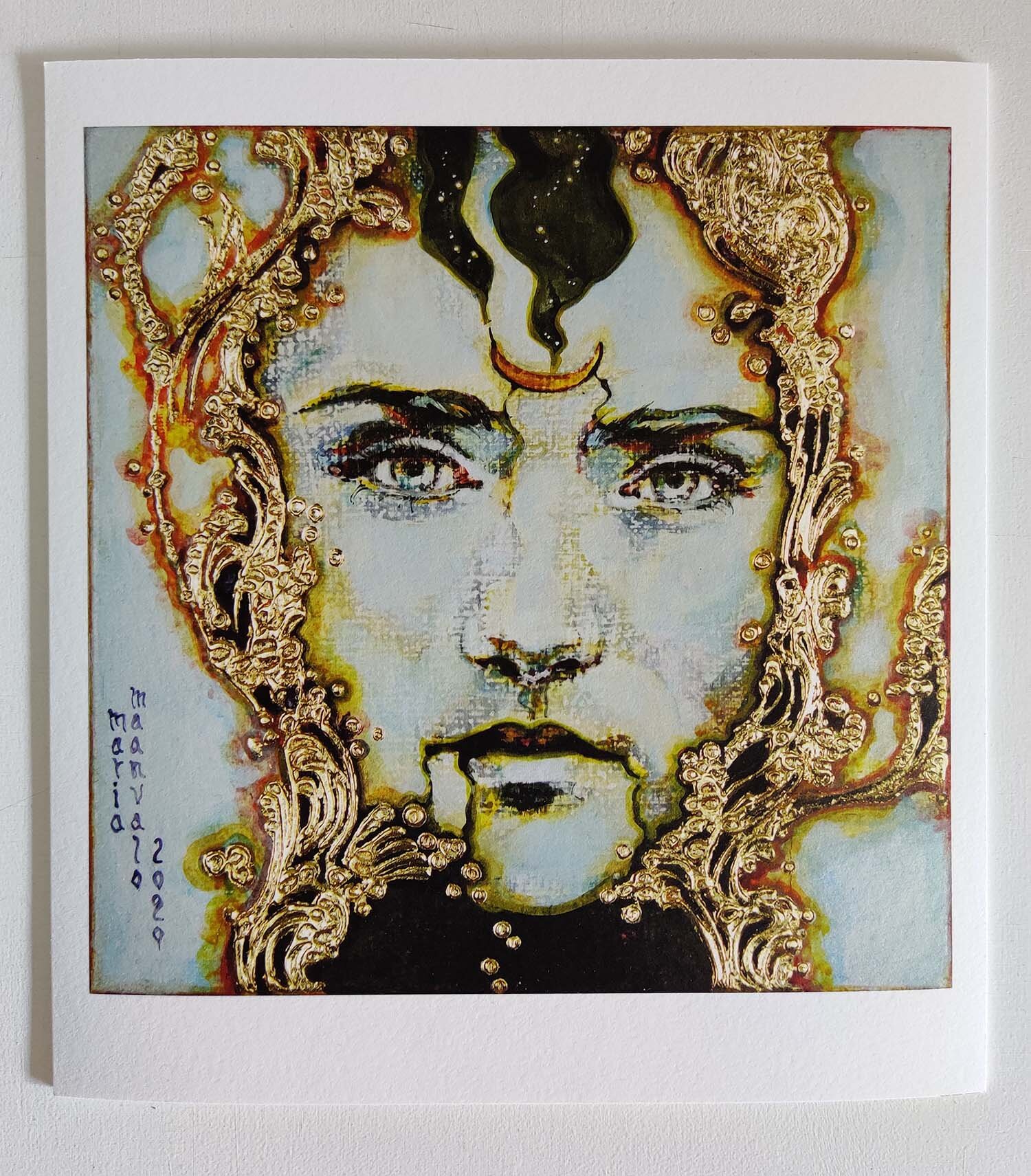Giclée prints
For so long i wanted to make giclée prints and now i have.
I made a test run of two digitally enhanced versions from my Moonflower III drawing. Approximately in the same scale as the original (one that’s behind me in the picture). And then 8 miniprints from my minipaintings to fit an envelope to ensure easy mailing.
They all turned out brilliant. The colors are very bright and reproduction matches the original. I love it as much as i always thought i would. Specially had fun making the big prints because i got to play with Photoshop first and create this vintage look with sloppy random/vague coloring.
In my Thyroid Demon print you can see the bumps of the structure that goes over the side on the top. And also the shape of the canvas.
So you can really get a true feeling of the original replicated. The closest you can get without the original.
Most of my paintings i cropped to make them tidier but the ones that had bumps got printed with their bumps.
First of all.
It might be good to point out that giclées are indeed made with a printer and not crafted by hand like my etchings. Both are called prints, but very different thing still.
I discovered giclée prints years ago when i saw artists that i liked, selling reproduction prints of their artwork. I saw it as affordable way to have their art on my wall. Art i would never be able to buy as original.
And from the start i have wanted to make giclées from my own paintings as well.
First. I like to offer people who like what i do, the same low threshold option to have my art on their wall.
Second. I spend so much time on painting one painting that i basically can never get paid for all that time and effort, at least not at this stage of my art career. That is especially the case with my bigger paintings. That high of a pricing is just not realistic. So even if it’s not the real deal - the actual painting, i can sell it as a print. And the third perk is that everybody who wants one gets to have one. With originals, once it’s gone it’s gone and nor you or anybody else can ever see it again. Except the owner. They can see it just by looking at it.
Selling only prints and not the originals also helps with exhibitions.
If i would have to (or was able to) sell the originals right away, i wouldn’t have much to show in my exhibitions. There’s only handful of paintings i manage to paint in a year for example so i don’t have too much to show people anyways.
So if i sell prints, i have less pressure to sell the original. Goody.
Two different color versions of Moonflower III and a 10 cm pea pod for a scale.
The lighter one has only backround color but the darker version has also more detailed pale colors on the figures and flowers. It is my favourite thing to do. Tinker in Photoshop. I love the old medicine bottle green and the coloring style of old photos, where they just added some general shades of color on top of black&white photos.
Tiny dancing Shiva with his damaru drum.
The colors are pale pastel ones. You can hardly see them but they liven up the drawing. For example on Shivas throat.
It is blue because he drank the poison what was feared would destroy the world and so he just casually drank it and stopped it at his throat. #onlyshivastuff
Why giclées?
What makes giclées different from regular prints like posters for example is the way they are made.
The quality.
Giclée prints are fine art prints that are made from a digital file with inkjet printer.
These high resolution prints are printed with pigment based inks, and on high quality acid free papers, both considered archival (doesn’t fade or alter with time, over 100 year guarantee if stored properly).
The artist is closely involved with the process of making the giclée prints, proofing the image, paper, size of the edition and signing the prints. And by making the original.
Some artists invest for a printer and also print their giclées by themselves. Many just use a fine art printing service.
Successful artists in the U.S. collaborate with galleries who sell their prints for the them. Also many of the young artists who present their art in social media have discovered giclées to be a nice & easy way to sell their art online. I have not detected a huge giclée market in Finland yet but there’s of course some people who do it.
To my understanding you can make giclées from paintings/drawings as reproductions and from photographs and digital art as the originals.
What makes giclées so valuable besides the quality (the fact that its quite expensive to get them printed in the first place), is that they are usually limited editions.
Artists decide the size of the edition and it also effects the pricing.
Smaller the edition, more valuable the prints are.
The number of the print and the size of the edition is signed below the picture by the artist as well as their name.
My 8 miniprints
I decided that my small envelope fitting prints are an open edition so that i can sell them cheaper. And if i ever make original size prints or bigger scale prints their editions will be limited to make them more special.
Upper ones: Thyroid Demon and Reconcile. And then the 6 from my Mother Earth series: Spirit, Infinity, Goddess, Mountain, Crown of creation and Cycle.
The original paintings are quite small so the scale of the prints is not that different.





